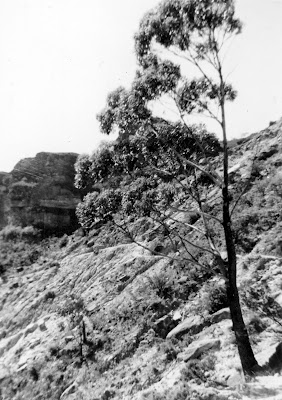Some of you might recall that I found a broken soft drink
bottle while on a walk at Lawson a few months ago. (The video may be found
here.) The complete wording on the bottle is “2D deposit charged which is refunded on return. This bottle is the
property of GEORGE DAVIES & Co
KATOOMBA”. The wording is unusual in that it shows the deposit as tuppence (twopence)
instead of the more usual penny. When I was a lad it had gone up to thrippence
(threepence). The reason for the 2D deposit would surely have been the great
loss of bottles that cordial makers in the Blue Mountains suffered from
nonreturns. Just like today, it seems to be harder to carry home an empty
bottle than to bring out a full one. Bring back deposits and make it a dollar at
least. I could use some extra cash!
%2B(800x600).jpg)
The only other marking is AGM on the base, denoting the
Australian Glass Manufacturers company (Sydney). This style is found on bottles
from around 1920/25.
.jpg) |
| George Davies Sr |
Although it is missing, no doubt the bottle had a machine
made crown seal top. I’ve seen other examples of this and similar bottles from
the company including the 26 ounce (oz) variety. My example is a 13 oz one;
there may be an even smaller 7 oz. There is also a crown seal stone ginger beer
and more than likely a much larger stoneware demijohn, soda syphons and
possibly 7 oz crown seal soda waters and amber glass ginger beers. The company
came into existence too late to have used the older marble bottles, torpedos etc.,
though they may have been used some of Rowlands bottles with paper labels until
their own were ready.
In those days every town had one or more soft drink
factories (always called cordial works then) and it is a great field for
collectors to acquire specimens and gather information about the makers. In
addition to the main centre of Katoomba, there were also cordial works in
Blackheath and Leura and possibly Lawson and Springwood.
I haven’t researched the subject in any detail yet, but the
names of Bronger and E Rowlands stand out. The firm of Bronger Bros (EW and RJ)
was established in Penrith around 1892 when they took over an existing business.
The bottles from this firm show a pair of shaking hands as their trademark, no
doubt a play on the word “cordial”. RJ Bronger moved to Katoomba in 1895 to
establish a cordial factory. This was on the corner of Murri and Kundibar
Streets and was subsequently converted into a modern ice works in 1919/20, the
water supply being drawn from a deep well on the site. The operator of the ice
works was WT Davies (son of George Davies).
The firm of E Rowlands had a long record going back to the
gold rush days in Ballarat, where Evan Rowlands began a cordial works in 1854.
The business expanded to Melbourne,
Sydney and Katoomba. Many of their bottles bear the celebrated "Miner and Farmer”
trade mark, though not the Katoomba ones, so far as I know. The connection with
Katoomba began in 1888, when land was purchased from which large quantities of
pure water were drawn. The water was dispatched to Sydney for use in the
factory there, later a cordial works was established on the site in Katoomba. This
was in Bent St and presumably the famous “Katoomba Spring” must have been there
too. We know for certain that George Davies and Co bought the E Rowlands
business in 1920 and that RJ Bronger was an employee of the Rowlands business
in 1906, when he lost an eye due to an exploding bottle. Presumably RJ Bronger
had ceased making his own aerated waters and went to work for Rowlands some time before.
To get back to George Davies. He appears to have been a coal
miner in the early days of Katoomba before becoming a successful butcher, in
which trade he continued for the next 40 years. He was Mayor of Katoomba five
times and always concerned for the future of his town. Most significantly, from
the point of view of this Blog, he was not a cordial maker. It appears that the
company “George Davies & Co” was established to provide employment for his
son WT Davies on his return from the Great War. We know a lot less about
William than his father, George. Something seems to have happened to the ice and
cordial businesses after George’s death in September 1923. William’s name
vanishes from the advertising after May 1924 and George Davies Junior’s name
appears from October that year. No more ads can be traced for the Ice Works after
November 1924. As for the aerated waters business, the last advertisement in
the “Blue Mountain Echo” appears to
be 16th October 1925 when the firm was looking for a “smart boy, about 16, to work in aerated
water factory”. There is an ad in “The Mountaineer” tourist guide for 1927,
but this publication was notoriously out of date.
You might say that this is just a taste of the George Davies
story. You can find further information on these sites using Trove (here) :
The Ice Works The
Blue Mountain Echo, Friday 23 January 1920, p 4
The E Rowlands Takeover The
Blue Mountain Echo, Friday 19 November 1920, p 2
George Davies obituary The
Blue Mountain Echo, Friday 14 September 1923, p 5
My Blue Mountains You Tube playlist may be found here. I have three other playlists - on gem hunting/fossicking, Glen Innes and New Zealand.
https://johnsbluemountainsblog.blogspot.com/2013/12/links-to-all-blog-entries-and-relevant.html
All Blue Mountains blogs and videos
All New England and other Geology blogs and videos
%2B(800x600).jpg)


.jpg)
.jpg)
.jpg)
.jpg)
.jpg)
.jpg)

%2B(2).jpg)
%2B(2).jpg)
%2B(2).jpg)


.jpg)
.jpg)
.jpg)

%2B(2).jpg)
.jpg)
.jpg)
.jpg)
.jpg)
.jpg)

.jpg)
.jpg)
.jpg)